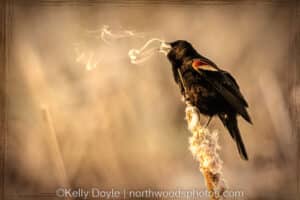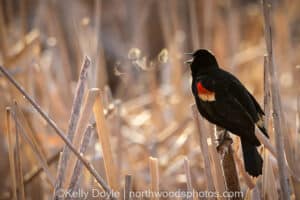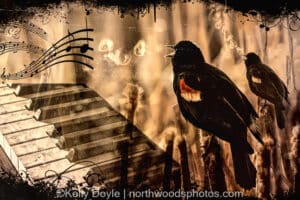One of my favorite things to do in the spring is go out birding – especially since the pandemic when everything else was shut down.
S[ring time is breeding season, which means the male birds are in their brightest colors and are actively singing to attract mates or defend territories.
Crisp, cool mornings are especially fun because you can actually “see” the songs the birds are singing.
Though I’ve witnessed “bird breath” by several species, the Red-Winged Blackbirds are my favorite for picture taking because it’s relatively easy to get close enough for a clean shot.
The males show up a few weeks before the females and actively stake out their spot in the marsh to raise their young.
They are easy to see in full view since they like to perch near the tops of cattails, which means no tree branches or leaves in the way.
Ideal Weather Conditions to Photograph Bird Breath
Ideally, you need a few things to line up in the weather department to pull this off:
- It needs to be cold enough to see breath. Step outside and test yourself. If you can see your breath, you’ll be able to see bird breath too.
- You want calm conditions. The less wind, the better.
- Bright days are better than heavily overcast days. It doesn’t need to be sunny, but you don’t want gloomy either.
Camera Gear & Settings
You’ll want a telephoto lens so that you can zoom in on the birds.
Even though you can get relatively close to Red-Winged Blackbirds, they are still small animals and you’ll want as much reach as possible. I typically shoot at 600 mm on a full frame DSLR and still have to crop more often than not.
Cameras these days are pretty amazing, so it doesn’t really matter if you shoot crop sensor or full frame, DSLR or mirrorless, etc. Even newer phones are coming out with zoom features, though I don’t know if they have enough for bird photography yet. You won’t know unless you try.
I shoot almost all wildlife hand-held since you never know where and when the critters show up (or for how long), so my shutter speeds are usually 1/2000 sec for bird photography with my 600 mm lens.
Choose what depth of field you want. The top image on this page has a shallow depth of field (smaller f number), which blurs out the cattails in the background. If you want more of the background in focus, adjust your f-stop to a smaller aperture (higher number).
Once you’ve got your shutter speed and depth of field decided, set your ISO accordingly.
Post-processing
Once you’ve got your images, what you choose to do with them is another topic.
I load all of my images in Adobe Lightroom Classic and do initial processing there. Lightroom is more than the develop module, it’s also very useful as a database for organizing images.
It’s pretty easy to get rid of noise in post-processing these days (my favorite tool for that is currently Topaz DeNoise AI, which also sharpens the image a bit). Topaz is coming out with a new flagship software called Photo AI which combines denoise, sharpening, and upsizing all in one app.
Bird breath photos are pretty cool just the way they are, but sometimes I like to play with compositing in Photoshop. I use lots of textures in my work, and also like to have fun with color palettes.
You can check out more in my online gallery.
Have fun learning how to photograph bird breath!


